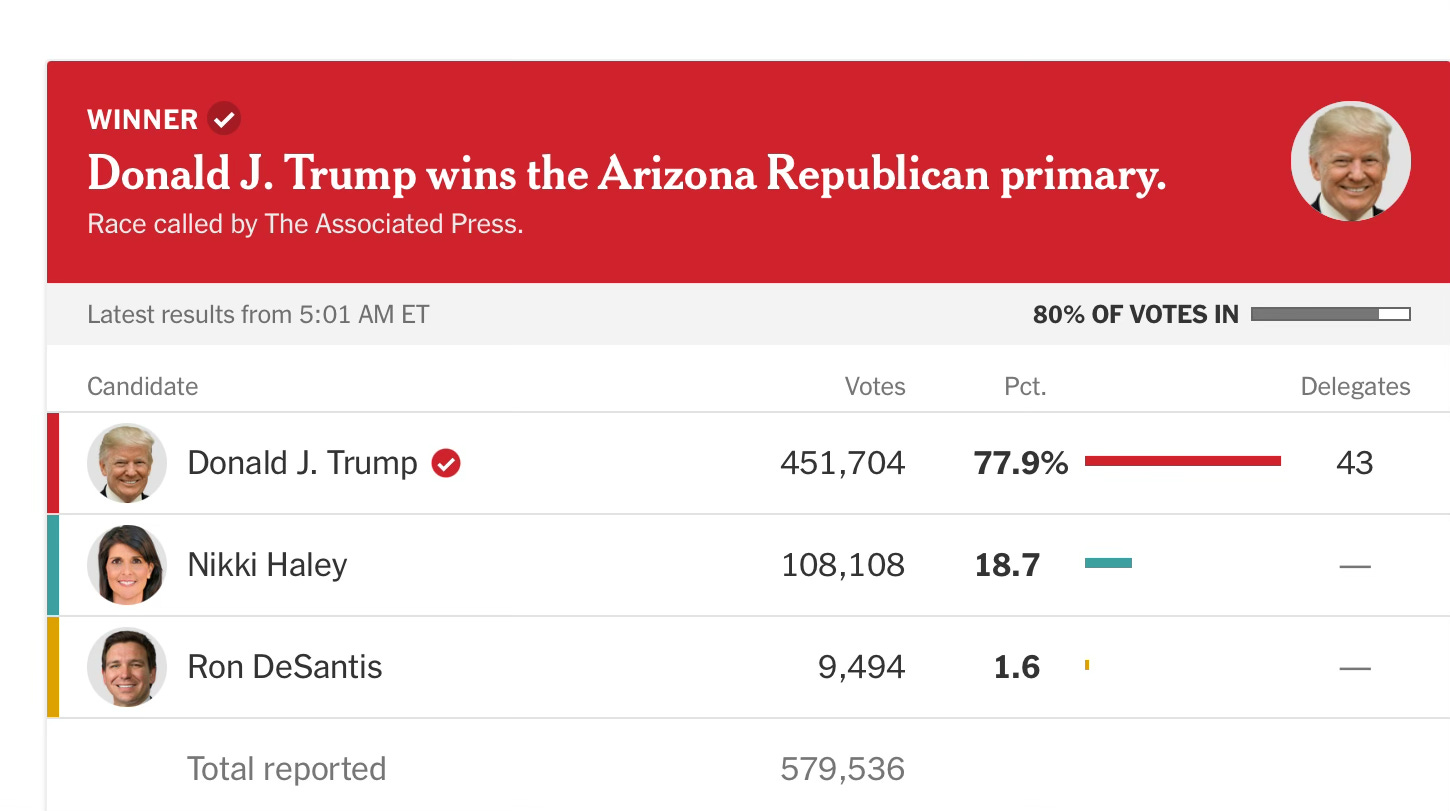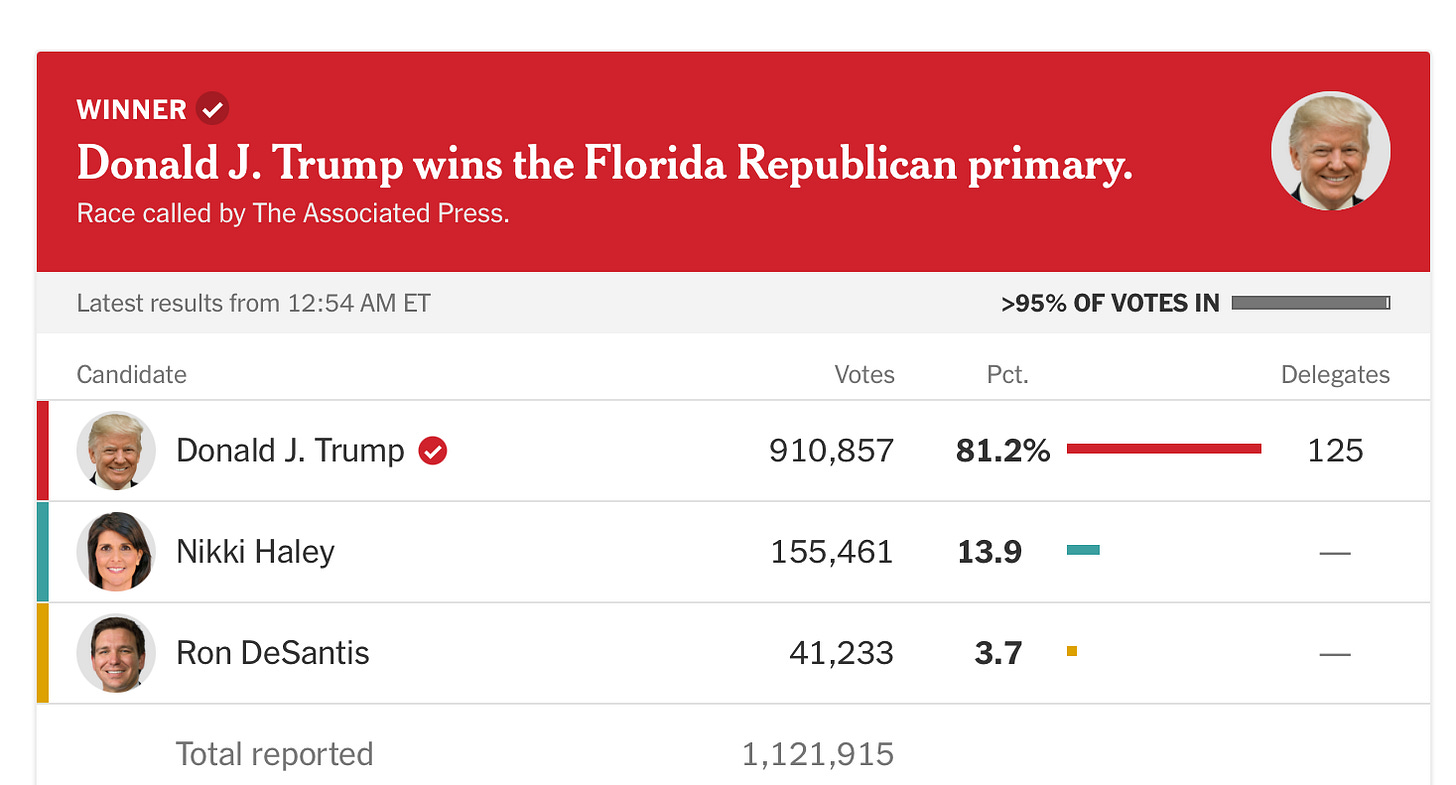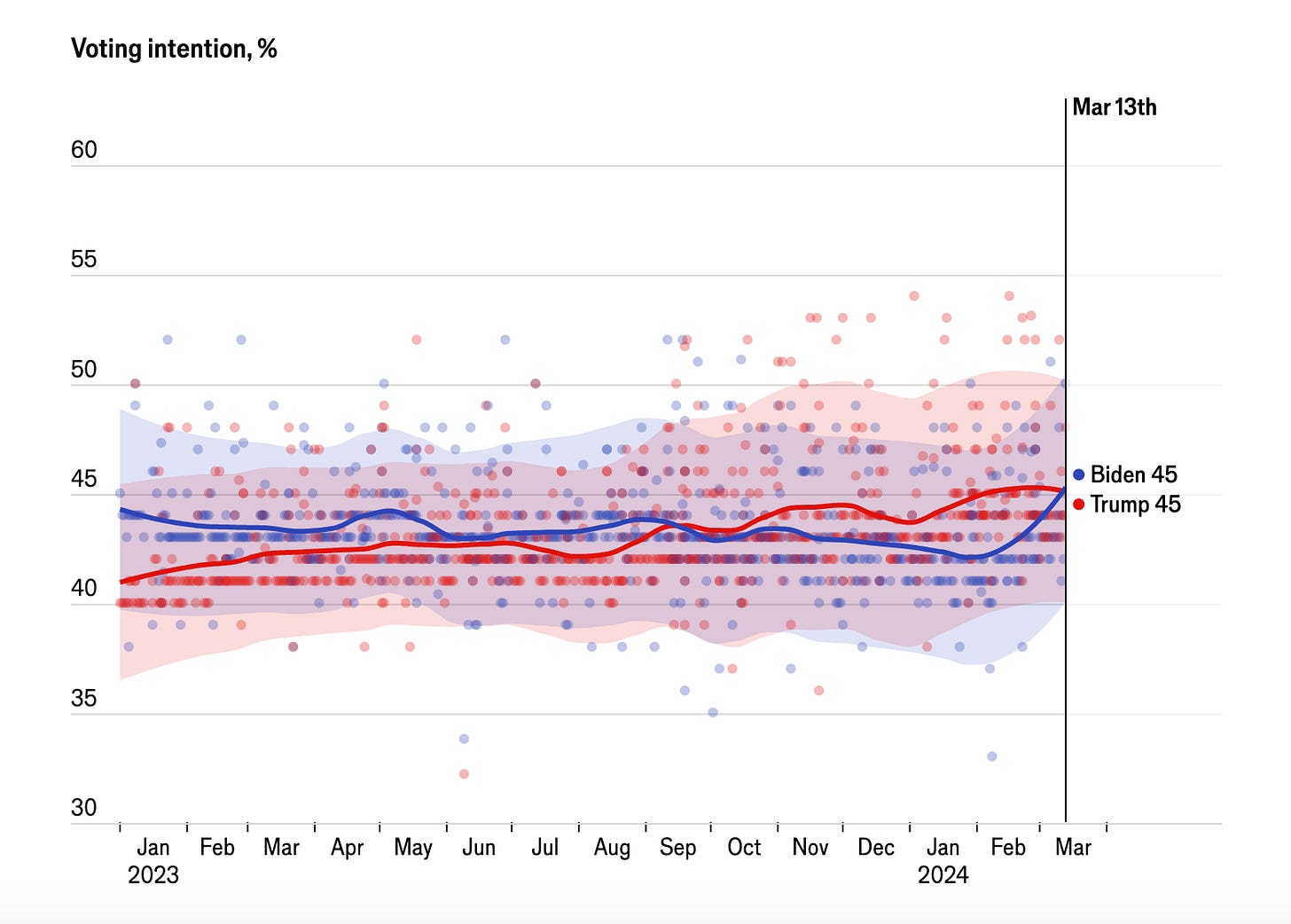Cautious Optimism
Tuesday’s primaries underscore Trump’s weaknesses; MAGA extremists dampen the GOP’s Senate chances; and the polls, should we care, actually hold some bright spots.
I’m sitting in an airport lounge in Cape Town, South Africa, and contemplating my return trip and the 27 hours of flight, layover and public transit ahead. So you’d think I’d be a tad grumpy. But it’s hard to feel that way as I digest the news and primary election returns from around the country!
Today I feel better about our chances in November than I did yesterday, and I already felt pretty decent. And it’s not just about defeating Trump, but about keeping MAGA out of power in Congress, too.
In this piece, I’ll cover three topics, each of which bears its own, unique cause for cautious optimism.
First, as the previous primaries have shown, Trump continues to underperform with voters in GOP primaries relative to how Biden is doing with voters in Democratic primaries. Even with Nikki Haley and the other challengers dropping out of the race, Trump is still losing between one-in-five and one-in-six GOP primary voters to other candidates. And a good chunk of those voters he will never get back.
Second, it appears MAGA either hasn’t learned the lesson of 2022 or it is wholly incapable of changing its spots when it comes to nominating extremist candidates. Those candidates are more likely to lose general elections, but they keep putting them up. In this case, they have nominated another extremist to represent the GOP in the crucial Ohio Senate seat race—a man named Bernie Moreno. He’ll face off against incumbent Sherrod Brown. And from where I sit, our chances of holding the Senate just ticked upward as a result.
Third, while I don’t want to focus too much on polls, I do want to point out two things. To the extent that people care, the national polling averages now show Biden with a slight lead over Trump, who had led in these averages since September. More importantly, within the separate polls over time, many show that voters have moved toward Biden by a few points. While polls are not predictive of final results this far out, it is still useful to see how things have moved relatively within the same poll, even if absolutely speaking, it may be way off.
Let’s take a closer look at these three discussion points.
Trump is weak, and the numbers don’t lie
Nikki Haley dropped out of the presidential race after Super Tuesday. But that hasn’t stopped many voters in the GOP primaries from voting for her anyway as a kind of protest against Trump. As of the time of this writing, for example, in the crucial swing state of Arizona, Haley has received nearly 19 percent of the vote—over 108K votes.
And in populous Maricopa County, Arizona, which was key to Biden’s win in 2020, her performance was even stronger. She has captured around 21 percent of that county’s vote so far at the time of this writing. Remember, it was swing voters in that county that helped deliver the governorship to Democrat Katie Hobbs over Kari Lake and return Mark Kelly to the Senate instead of sending Blake Masters. (Both Lake and Masters were MAGA extremists—more on that below.)
In other states, including Illinois, Kansas and Ohio, the story was much the same, with Trump earning under 80 percent of the vote while Biden earned well over it. But of particular interest to me was Florida, which held a Republican primary contest while the Democrats canceled theirs. While other states such as Arizona, Ohio and Kansas held “partially closed” primaries, meaning independents could vote in them, Florida held a completely closed primary, meaning only Republicans could participate. You’d think Trump would hit the high 90s in such a state, but he again fell short, with nearly one in five voters choosing someone else:
As Ron Filipkowski observed, Trump continues to struggle with suburban white voters, the kind that live in Maricopa County or the counties around big cities like Philadelphia, Milwaukee and Detroit. Trump won those voters in 2016, but he lost them in 2020, and it looks like most are not coming back in 2024. Indeed, Trump has given them no solid reason to come back and many reasons not to—from the loss of abortion rights to his attempted coup, from scores of criminal charges to a civil jury verdict against him on sexual assault.
In exit polls from the states that have already held primaries, somewhere between 10 to 15 percent of Republicans say they will not vote for Trump in the general election. While some may indeed change their minds and “come home” to the party, others will vote third party, stay home, or cross over to vote for Biden.
We already saw a version of that happen in the battleground states in the 2022 midterm elections. A significant number of Republican voters refused to check a box for Trump-backed candidates at the top of the ticket, leading to many defeats in Pennsylvania, Arizona, Michigan, Georgia and Wisconsin. It was why Democrats held the Senate in 2022 and created trifectas of government in Michigan and eventually in Pennsylvania, once the dust settled. With Trump’s name actually on the ticket this time, it’s unlikely those voters will have a sudden change of heart.
But couldn’t MAGA enthusiasm for Trump create more support for him than he has lost? In theory, yes. But demographic shifts over time haven’t been on Trump’s side either. His core supporters tend to be older, white Americans, and there are many millions fewer of them than the last time he won eight years ago, all while the number of younger, diverse Gen Z voters who heavily favor Biden has risen in that same time period. Trump will very much need those “Haley” voters to come back to the fold in order to repeat what he did in 2016, and right now it sure looks like they don’t want to.
An extremist, again, on the ballot in a key Senate race
The current make-up of the Senate is 51-49 in favor of the Democrats. That means that, in order to retake the majority in the chamber, Republicans will need to flip two seats. The map for the GOP is highly favorable, with Democrats defending key seats in multiple contests.
And with Sen. Joe Manchin of West Virginia unlikely to run again, it really means that Republicans need to win just one close contest to prevail. The most likely places for them to do that are in Montana with Sen. Jon Tester’s seat or in Ohio with Sen. Sherrod Brown’s seat. And both are fairly popular Democratic incumbents who live in states that are solidly red for Trump.
That’s why it is rather big news that the GOP has selected Bernie Moreno as their candidate to face Sen. Brown in November. This is an outcome that the “establishment” GOP really didn’t want, but Trump pushed hard for with his endorsement of Moreno. Candidate quality has never been Trump’s strongpoint, as he values loyalty over electability, creating problems for the GOP eager to hold on to moderate voters. As Democratic strategist Sawyer Hackett noted,
Republicans just nominated a Senate candidate in Ohio who:
-is anti-LGBT, but was found to have signed up for a casual gay sex site
-was sued for race, gender, and age discrimination
-was held liable for $400K in wage theft
-supports national abortion ban without exceptions
All the best people.
Democrats strongly prefer facing Moreno over the more moderate, and therefore more electable, primary contenders—so much so that they ran a controversial ad campaign that labeled Moreno as too conservative and too MAGA for Ohio. They knew that this would have the dual effect of turning moderate voters off from Moreno even while increasing his support among MAGA primary voters. This is a high risk strategy that increases polarization while leading to notable electoral losses for the GOP.
Sen. Sherrod Brown now will have an easier time targeting his opponent as out-of-touch with ordinary voters, especially on the subject of abortion. And the hypocrisy of Moreno over LGBTQ+ rights, particularly if the rumors of his closeted life prove true, will also erode his support.
If Tester of Montana can hang on to his seat and Brown defeats Moreno in Ohio, then the chances that Democrats retain control of the Senate go up considerably.
On a roll with the poll averages
Two things can be true: The national polls can be way off, and they can also show a decided shift toward Biden.
In an earlier piece, I wrote about how the polls keep overestimating Trump’s strength in the primaries, often by double digits. I cautioned that we shouldn’t read too much into polls that have faulty methodology or produce absurd results.
That said, it remains useful to look at the same poll over time to see if we can discern a general directional shift. And in this case, it appears that we can. Writer and self-described political junkie Zac Harmon notes that over the past two months, many of the national polls have actually shifted to a Biden lead where they used to show a tie or a Trump advantage:
Comparisons of national polls taken in Jan/Feb to ones taken in March so far:
Emerson +1 Trump—> +2 Biden (RV)
TIPP +2 Trump—> +2 Biden (RV)
Ipsos +0 (tied)—> +2 Biden (A/RV)
KFF +4 Trump—> +3 Biden (RV)
Civiqs +0 (tied)—> +1 Biden (RV)
FAU +4 Trump—> + 2 Biden (LV)
Note that this does not mean, in my view, that Biden is actually leading, any more than that Trump was once actually ahead. What it does show, all factors being the same within each individual poll, is a decided shift toward Biden.
Think of it as a thermometer that may not work properly enough to tell you the exact temperature right now, but will tell you if it somehow got three degrees cooler lately in general. That is what these polls are telling us: The movement is toward Biden.
This of course won’t get headline coverage like a New York Times / Siena College poll showing Trump in the lead did. Major media won’t report that Biden is surging lately and actually slightly ahead of Trump in the polling averages, according to the Economist tracker:
Now, I don’t want to overstate the case. Public opinion is fluid, Biden may have gotten a temporary bump from the State of the Union, Trump could score more court delays, and these numbers could shift again. But the larger point is that polls shift, and we shouldn’t let a series of bad polls affect our spirits any more than we should allow good polls to grant us unwarranted confidence.
Still, narratives matter. And the narrative today should be that Biden has the momentum, Trump’s support is weak, while MAGA is making more unforced errors with unappealing, extremist candidates. And so I remain cautiously optimistic, which is where I hope my readers land as well.
We have much work to do. But this election is winnable, and as Democratic strategist Simon Rosenberg likes to say, I would far rather by us than them, looking at this data.






Jay, I have to say I'm amazed you can field all these things when you're on vacation. Thanks again for your diligence in creating one of the most useful substacks out there.
The only thing that’s ever really put a dent in Trump’s popularity is when people actually hear the things he says and believes. Which is ironic because, as a narcissist domestic abuser, it’s what he craves more than anything.
I’m glad you properly characterized the Democratic Moreno ads—they do NOT “promote” the most despicable candidates. They are quite clear about how terrible their subjects are. It’s the Republicans’ knee-jerk “the worse they are, the more I like them” reaction that turns it into a “promotion.” And the tactic has been extremely successful.
Good luck on the travel! Door-to-door to my in-laws is 31 hours, so I feel your pain.